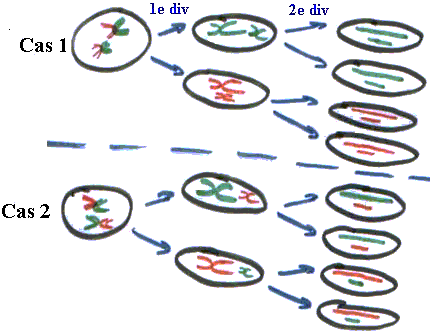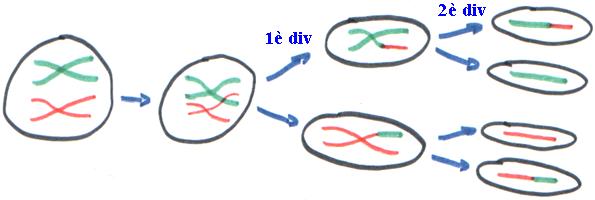Le coin des amatheurs de sciences version 2 
The sections of the site : The site  FORUM
FORUM  The space
The space  The genetics
The genetics  Medicine
Medicine  Physics
Physics  Tintin and science
Tintin and science  Ecology - Nuclear energy
Ecology - Nuclear energy  Mysteries of the history
Mysteries of the history  Humour
Humour  Diverse
Diverse
Le coin des amatheurs de sciences version 2 
The sections of the site : The site  FORUM
FORUM  The space
The space  The genetics
The genetics  Medicine
Medicine  Physics
Physics  Tintin and science
Tintin and science  Ecology - Nuclear energy
Ecology - Nuclear energy  Mysteries of the history
Mysteries of the history  Humour
Humour  Diverse
Diverse
To understand this page, you should firstly read : Bases of the genetics, The synthesis of proteins, The mitosis, The changes.
All the individuals, even inside a family, are very different. That results from a mixing of genes during the sexual reproduction. This mixing can take place at several times.
I) During the meiosis
The meiosis is division making it possible to produce gametes. Its mechanism is very close to that of the mitosis, except which it contains two divisions. Let us pass on the details, essence is that the meiosis makes it possible to pass from a cell to 2n chromosomes containing each one 2 chromatides (n = 23 for the man) to four cells containing n chromosomes with a chromatide, these four cells being the gametes. The first division consists in separating the chromosomes (one of each pair in each new cell), the second separates the chromatides. During the meiosis, two mixings can take place.
1) interchromosomic mixing
The distribution of the chromosomes during the meiosis depends only on their placement before the first division, as explains it the following diagram :

According to the placement of the chromosomes at the time of the first division, one can obtain either 4 gametes of the parental types (first case), or 4 gametes of the recombined types (second case).
The possibilities are very numerous : it is seen that for 4 chromosomes, one obtains 4 gamètes possible. For 6 chromosomes, there will be 23 = 8 of them and for 46 chromosomes, like the mankind, there are 223 = 8 388 608 possibilities.
2) intrachromosomic mixing
At the beginning of the meiosis, the chromosomes of the same pair are coast at coast and can cross. That involves sometimes exchanges : parts of chromosomes are exchanged as shows it the following diagram :

This type of mixing, rather rare, is called crossing-over.
II) During fecundation
During fecundation, a male gamete meets a female gamete, both gametes being taken completely randomly among all produced gametes. By adding the fact that the number of different gametes for each sex is very large, the crossing gives an exorbitant number of possibilities.
For example, for the man (46 chromosomes) : each man and woman can produce 223 different gametes, without holding account of the crossing-over. Thus, at the time of the meeting of the gametes, the number of different egg-cells which can be obtained is 246 i. e. approximately seventy thousand billion. If one holds account in more of the crossing-over, this number becomes a lot larger...